南京大学:《信息与计算科学导论》课程教学资源(课件讲稿)集合与关系 Sets-and-Relations

SETS AND RELATIONS Sheng Zhong Nanjing University Email:zhongshengen ju.edu.cn
SETS AND RELATIONS Sheng Zhong Nanjing University Email: zhongsheng@nju.edu.cn
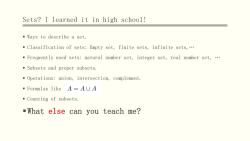
Sets?I learned it in high school! Ways to describe a set. Classification of sets:Empty set,finite sets,infinite sets,.. Frequently used sets:natural number set,integer set,real number set,. Subsets and proper subsets. Operations:union,intersection,complement. ·Formulas1ikeA=AUA ■Counting of subsets. -What else can you teach me?
Sets? I learned it in high school! Ways to describe a set. Classification of sets: Empty set, finite sets, infinite sets,… Frequently used sets: natural number set, integer set, real number set, … Subsets and proper subsets. Operations: union, intersection, complement. Formulas like Counting of subsets. What else can you teach me?
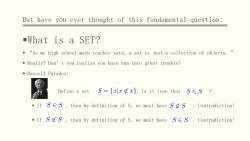
But have you ever thought of this fundamental question: ■What is a SET? "As my high school math teacher said,a set is just a collection of objects. Really?Don't you realize you have run into great trouble! ■Russell Paradox: Define a set S={xxx}.Is it true that S∈S? ■IfS∈S,then by definition of S,we must have Ss·Contradiction! If Ss,then by definition of S,we must have SES.Contradiction!
But have you ever thought of this fundamental question: What is a SET? “As my high school math teacher said, a set is just a collection of objects. ” Really? Don’t you realize you have run into great trouble! Russell Paradox: Define a set . Is it true that ? If , then by definition of S, we must have . Contradiction! If , then by definition of S, we must have . Contradiction!
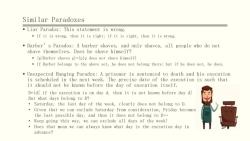
Similar Paradoxes Liar Paradox:This statement is wrong. If it is wrong,then it is right;if it is right,then it is wrong. Barber's Paradox:A barber shaves,and only shaves,all people who do not shave themselves.Does he shave himself? (p|Barber shaves p}={plp does not shave himself} If Barber belongs to the above set,he does not belong there;but if he does not,he does. Unexpected Hanging Paradox:A prisoner is sentenced to death and his execution is scheduled in the next week.The precise date of the execution is such that it should not be known before the day of execution itself. D={d if the execution is on day d,then it is not known before day d} But what days belong to D? Saturday,the last day of the week,clearly does not belong to D. Given that we can exclude Saturday from consideration,Friday becomes the last possible day,and thus it does not belong to D... Keep going this way,we can exclude all days of the week! Does that mean we can always know what day is the execution day in advance?
Similar Paradoxes Liar Paradox: This statement is wrong. If it is wrong, then it is right; if it is right, then it is wrong. Barber’s Paradox: A barber shaves, and only shaves, all people who do not shave themselves. Does he shave himself? {p|Barber shaves p}={p|p does not shave himself} If Barber belongs to the above set, he does not belong there; but if he does not, he does. Unexpected Hanging Paradox: A prisoner is sentenced to death and his execution is scheduled in the next week. The precise date of the execution is such that it should not be known before the day of execution itself. D={d| if the execution is on day d, then it is not known before day d} But what days belong to D? • Saturday, the last day of the week, clearly does not belong to D. • Given that we can exclude Saturday from consideration, Friday becomes the last possible day, and thus it does not belong to D… • Keep going this way, we can exclude all days of the week! • Does that mean we can always know what day is the execution day in advance?
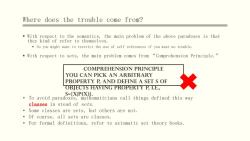
Where does the trouble come from? With respect to the semantics,the main problem of the above paradoxes is that they kind of refer to themselves. "So you might want to restrict the use of self references if you want no trouble. With respect to sets,the main problem comes from "Comprehension Principle. COMPREHENSION PRINCIPLE YOU CAN PICK AN ARBITRARY PROPERTY P.AND DEFINE A SET S OF OBJECTS HAVING PROPERTY P,LE., S-XP(X)). To avoid paradoxes,mathematicians call things defined this way classes in stead of sets. Some classes are sets,but others are not. Of course,all sets are classes. For formal definitions,refer to axiomatic set theory books
Where does the trouble come from? With respect to the semantics, the main problem of the above paradoxes is that they kind of refer to themselves. So you might want to restrict the use of self references if you want no trouble. With respect to sets, the main problem comes from “Comprehension Principle.” Comprehension Principle You can pick an arbitrary property p, and define a set S of objects having property p, i.e., S={x|p(x)}. • To avoid paradoxes, mathematicians call things defined this way classes in stead of sets. • Some classes are sets, but others are not. • Of course, all sets are classes. • For formal definitions, refer to axiomatic set theory books
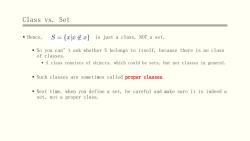
Class vs.Set ■Hence,. S=fxxgx}is just a class,NOT a set. So you can't ask whether S belongs to itself,because there is no class of classes. A class consists of objects,which could be sets,but not classes in general. Such classes are sometimes called proper classes. Next time,when you define a set,be careful and make sure it is indeed a set,not a proper class
Class vs. Set Hence, is just a class, NOT a set. So you can’t ask whether S belongs to itself, because there is no class of classes. A class consists of objects, which could be sets, but not classes in general. Such classes are sometimes called proper classes. Next time, when you define a set, be careful and make sure it is indeed a set, not a proper class
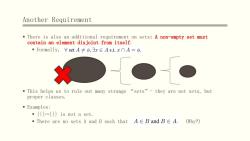
Another Requirement There is also an additional requirement on sets:A non-empty set must contain an element disjoint from itself. ·Formally,V set A卡p,3x∈Ast.xnA=p. "This helps us to rule out many strange "sets"-they are not sets,but proper classes. ■Examples: ■{{…}}is not a set. There are no sets A and B such that A∈B and B∈A. (Why?)
Another Requirement There is also an additional requirement on sets: A non-empty set must contain an element disjoint from itself. Formally, This helps us to rule out many strange “sets”- they are not sets, but proper classes. Examples: {{{…}}} is not a set. There are no sets A and B such that (Why?)
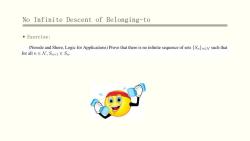
No Infinite Descent of Belonging-to ■Exercise: (Nerode and Shore,Logic for Applications)Prove that there is no infinite sequence of sets {SnE such that for all n∈N,Sn+1∈Sn
No Infinite Descent of Belonging-to Exercise:
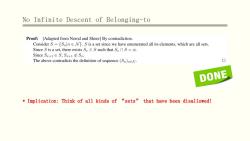
No Infinite Descent of Belonging-to Proof:[Adapted from Nerod and Shore]By contradiction. Consider S={SnnN.S is a set since we have enumerated all its elements,which are all sets. Since S is a set,there exists SE S such that Sns=. Since Sz+1∈S,Sx+1年Sx: The above contradicts the definition of sequence(Sn)nEN. DONE Implication:Think of all kinds of "sets"that have been disallowed!
No Infinite Descent of Belonging-to Implication: Think of all kinds of “sets” that have been disallowed!
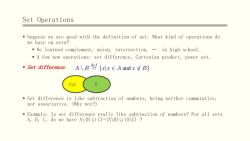
Set Operations Suppose we are good with the definition of set.What kind of operations do we have on sets? We learned complement,union,intersection,.in high school. A few new operations:set difference,Cartesian product,power set. ·Set difference: :A\Beg{xlx∈A andB} A\B B Set difference is like subtraction of numbers,being neither commutative, nor associative.(Why not?) Example:Is set difference really like subtraction of numbers?For all sets A,B,C,do we have A\(BU C)=(A\B)U(A\C)?
Set Operations Suppose we are good with the definition of set. What kind of operations do we have on sets? We learned complement, union, intersection, … in high school. A few new operations: set difference, Cartesian product, power set. Set difference: Set difference is like subtraction of numbers, being neither commutative, nor associative. (Why not?) Example: Is set difference really like subtraction of numbers? For all sets A, B, C, do we have A\(B ∪ C)=(A\B)∪(A\C) ? A\B B
按次数下载不扣除下载券;
注册用户24小时内重复下载只扣除一次;
顺序:VIP每日次数-->可用次数-->下载券;
- 长沙医学院:信息工程学院课程简介.pdf
- 中国科学技术大学:《信息检索与数据挖掘》课程教学资源(课件讲稿)第12章 Web搜索.pdf
- 中国科学技术大学:《信息检索与数据挖掘》课程教学资源(课件讲稿)数据挖掘经典算法概述.pdf
- 中国科学技术大学:《信息检索与数据挖掘》课程教学资源(课件讲稿)图像分类的算法思想.pdf
- 中国科学技术大学:《信息检索与数据挖掘》课程教学资源(课件讲稿)第11章 文本聚类.pdf
- 中国科学技术大学:《信息检索与数据挖掘》课程教学资源(课件讲稿)概率图及主题模型 Probabilistic Graphical Models Topic Model.pdf
- 中国科学技术大学:《信息检索与数据挖掘》课程教学资源(课件讲稿)第10章 文本分类(支持向量机及机器学习方法).pdf
- 中国科学技术大学:《信息检索与数据挖掘》课程教学资源(课件讲稿)第10章 文本分类(基于向量空间的文本分类).pdf
- 中国科学技术大学:《信息检索与数据挖掘》课程教学资源(课件讲稿)第10章 文本分类(文本分类及朴素贝叶斯方法).pdf
- 中国科学技术大学:《信息检索与数据挖掘》课程教学资源(课件讲稿)矩阵分解在信息检索中的应用.pdf
- 中国科学技术大学:《信息检索与数据挖掘》课程教学资源(课件讲稿)课程要求(论文阅读&研讨).pdf
- 中国科学技术大学:《信息检索与数据挖掘》课程教学资源(课件讲稿)第9章 基于语言建模的检索模型.pdf
- 中国科学技术大学:《信息检索与数据挖掘》课程教学资源(课件讲稿)第8章 概率模型.pdf
- 中国科学技术大学:《信息检索与数据挖掘》课程教学资源(课件讲稿)第7章 相关反馈和查询扩展.pdf
- 中国科学技术大学:《信息检索与数据挖掘》课程教学资源(课件讲稿)第6章 检索的评价.pdf
- 中国科学技术大学:《信息检索与数据挖掘》课程教学资源(课件讲稿)第5章 向量模型及检索系统 5.2 检索系统.pdf
- 中国科学技术大学:《信息检索与数据挖掘》课程教学资源(课件讲稿)第5章 向量模型及检索系统 5.1 向量模型.pdf
- 中国科学技术大学:《信息检索与数据挖掘》课程教学资源(课件讲稿)第4章 索引构建与索引压缩 4.2 索引压缩.pdf
- 中国科学技术大学:《信息检索与数据挖掘》课程教学资源(课件讲稿)第4章 索引构建与索引压缩 4.1 索引构建.pdf
- 中国科学技术大学:《信息检索与数据挖掘》课程教学资源(课件讲稿)第3章 词项词典和倒排记录表.pdf
- 南京大学:《信息与计算科学导论》课程教学资源(课件讲稿)递归算法与递归方程 Recursive Algorithm and Recurrence Relations.pdf
- 《管理信息系统》课程教学资源(书籍教材)第2章 管理信息系统的技术基础.pdf
- 国家中医药管理局:中医医院信息系统基本功能规范(修订,征求意见稿,2019年3月).pdf
- 北京中医药大学:《数据科学导论》课程教学资源(PPT课件)第1章 绪论 Introduction to Data Science(主讲:韩爱庆).pptx
- 北京中医药大学:《数据科学导论》课程教学资源(PPT课件)第2章 计算机基础.pptx
- 北京中医药大学:《数据科学导论》课程教学资源(PPT课件)第3章 计算机网络.pptx
- 北京中医药大学:《数据科学导论》课程教学资源(PPT课件)第4章 数据科学理论基础.pptx
- 北京中医药大学:《数据科学导论》课程教学资源(课件讲稿)大数据与卫生管理(主讲:李瑞锋).pdf
- 北京中医药大学:《数据科学导论》课程教学资源(PPT课件)大数据概述(主讲:唐燕).ppt
- 北京中医药大学:《数据科学导论》课程教学资源(PPT课件)数据科学视角下的中医药.pptx
- 北京中医药大学:《数据科学导论》课程教学资源(PPT课件)人工智能导论.pptx
- 北京中医药大学:《数据科学导论》课程教学资源(课件讲稿)自然语言处理入门(主讲:郭凤英).pdf
- 广州开放大学:《物业信息管理系统设计》考试试卷试题.docx
- 广州开放大学:《物业信息管理系统设计》考试试卷答案.docx
- 广州开放大学:《物业信息管理系统设计》测试1第一篇 智能建筑系统工程概述(试题).docx
- 广州开放大学:《物业信息管理系统设计》测试1第一篇 智能建筑系统工程概述(答案).docx
- 广州开放大学:《物业信息管理系统设计》测试1试卷试题.docx
- 广州开放大学:《物业信息管理系统设计》测试1试卷答案.docx
- 广州开放大学:《物业信息管理系统设计》测试2第二篇 智能建筑系统工程设计(试题).docx
- 广州开放大学:《物业信息管理系统设计》测试2第二篇 智能建筑系统工程设计(答案).docx
